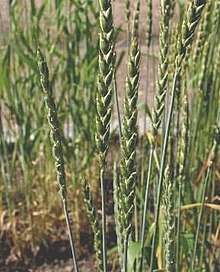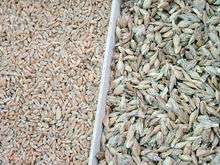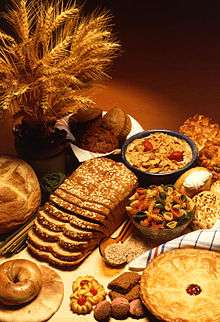Spelt
Spelt (Triticum spelta; Triticum dicoccum[2]), also known as dinkel wheat[3] or hulled wheat,[3] is a species of wheat that has been cultivated since approximately 5000 BC.
| Spelt | |
|---|---|
 | |
| Scientific classification | |
| Kingdom: | Plantae |
| Clade: | Tracheophytes |
| Clade: | Angiosperms |
| Clade: | Monocots |
| Clade: | Commelinids |
| Order: | Poales |
| Family: | Poaceae |
| Subfamily: | Pooideae |
| Genus: | Triticum |
| Species: | T. spelta |
| Binomial name | |
| Triticum spelta | |
| Synonyms[1] | |
| |
Spelt was an important staple food in parts of Europe from the Bronze Age to medieval times. Now it survives as a relict crop in Central Europe and northern Spain, and has also found a new market as a "health food". Spelt is sometimes considered a subspecies of the closely related species common wheat (Triticum aestivum), in which case its botanical name is considered to be Triticum aestivum subsp. spelta. It is a hexaploid wheat, which means it has six sets of chromosomes.

Evolution
Spelt has a complex history. It is a wheat species known from genetic evidence to have originated as a naturally occurring hybrid of a domesticated tetraploid wheat such as emmer wheat and the wild goat-grass Aegilops tauschii. This hybridisation must have taken place in the Near East because this is where Aegilops tauschii grows, and it must have taken place before the appearance of common or bread wheat (Triticum aestivum, a hexaploid free-threshing derivative of spelt) in the archaeological record about 8,000 years ago.
Genetic evidence shows that spelt wheat can also arise as the result of the hybridisation of bread wheat and emmer wheat, although only at some date following the initial Aegilops–tetraploid wheat hybridisation. The much later appearance of spelt in Europe might thus be the result of a later, second, hybridisation between emmer and bread wheat. Recent DNA evidence supports an independent origin for European spelt through this hybridisation.[4] Whether spelt has two separate origins in Asia and Europe, or single origin in the Near East, is currently unresolved.[4][5]
History
In Greek mythology spelt (ζειά [zeiá] in Greek) was a gift to the Greeks from the goddess Demeter. The earliest archaeological evidence of spelt is from the fifth millennium BC in Transcaucasia, north-east of the Black Sea, though the most abundant and best-documented archaeological evidence of spelt is in Europe.[6] Remains of spelt have been found in some later Neolithic sites (2500–1700 BC) in Central Europe.[6][7] During the Bronze Age, spelt spread widely in central Europe. In the Iron Age (750–15 BC), spelt became a principal wheat species in southern Germany and Switzerland, and by 500 BC, it was in common use in southern Britain.[6]
References to the cultivation of spelt wheat in Biblical times (see matzo), in ancient Egypt and Mesopotamia and in ancient Greece are incorrect and result from confusion with emmer wheat.[8]
In the Middle Ages, spelt was cultivated in parts of Switzerland, Tyrol, Germany, northern France and the southern Netherlands.[9] Spelt became a major crop in Europe in the 9th century CE, possibly because it is husked, unlike other grains, and therefore more adaptable to cold climates and is more suitable for storage.[10]
Spelt was introduced to the United States in the 1890s. In the 20th century, spelt was replaced by bread wheat in almost all areas where it was still grown. The organic farming movement revived its popularity somewhat toward the end of the century, as spelt requires less fertilizer. Since the beginning of the 21st century, spelt became a common wheat substitute for making artisanal loaves of bread, kinds of pasta, and flakes.[11] By 2014, the grain was popular in the UK with the crop being grown there as well as in Kazakhstan and Ukraine, with shortages reported.[12]
Nutrition
| Nutritional value per 100 g (3.5 oz) | |
|---|---|
| Energy | 1,415 kJ (338 kcal) |
70.19 g | |
| Starch | 53.92 g |
| Dietary fibre | 10.7 g |
2.43 g | |
| Polyunsaturated | 1.258 g |
14.57 g | |
| Vitamins | Quantity %DV† |
| Thiamine (B1) | 32% 0.364 mg |
| Riboflavin (B2) | 9% 0.113 mg |
| Niacin (B3) | 46% 6.843 mg |
| Vitamin B6 | 18% 0.230 mg |
| Folate (B9) | 11% 45 μg |
| Vitamin E | 5% 0.79 mg |
| Minerals | Quantity %DV† |
| Calcium | 3% 27 mg |
| Iron | 34% 4.44 mg |
| Magnesium | 38% 136 mg |
| Manganese | 143% 3.0 mg |
| Phosphorus | 57% 401 mg |
| Potassium | 8% 388 mg |
| Sodium | 1% 8 mg |
| Zinc | 35% 3.28 mg |
| Other constituents | Quantity |
| Water | 11.02 g |
| |
| †Percentages are roughly approximated using US recommendations for adults. | |
A 100-gram (3 1⁄2-ounce) reference serving of uncooked spelt provides 1,410 kilojoules (338 kilocalories) of food energy and is a rich source (20% or more of the Daily Value) of protein, dietary fiber, several B vitamins, and numerous dietary minerals (table). Highest nutrient contents include manganese (143% DV), phosphorus (57% DV), and niacin (46% DV). Spelt contains about 70% total carbohydrates, including 11% as dietary fibre, and is low in fat (table).
Spelt contains gluten and is therefore suitable for baking, but this component also makes it unsuitable for people with gluten-related disorders,[13] such as celiac disease,[14] non-celiac gluten sensitivity, and wheat allergy.[13] In comparison to hard red winter wheat, spelt has a more soluble protein matrix characterized by a higher gliadin:glutenin ratio.[15][16]
Products
In Germany and Austria, spelt loaves and rolls (Dinkelbrot) are widely available in bakeries as is spelt flour in supermarkets. The unripe spelt grains are dried and eaten as Grünkern ("green grain"). In Poland, spelt breads and flour are commonly available as health foods and easy to find in bakeries.
Dutch jenever makers distill with spelt.[17] Beer brewed from spelt is sometimes seen in Bavaria[18] and Belgium,[19] and spelt is distilled to make vodka in Poland.
Literary references
Spelt is currently a specialty crop, but its popularity in the past as a peasants' staple food has been attested in literature. Although today's Russian-speaking children perhaps do not know exactly what polba (spelt) looks or tastes like,[20] they may recognize the word as something that can be made into porridge, having heard Pushkin's well-rhymed story in which the poor workman Balda asks his employer the priest "to feed me boiled spelt" ("есть же мне давай варёную полбу").[21] In Horace's Satire 2.6 (late 31–30 BC), which ends with the story of the Country Mouse and the City Mouse, the country mouse eats spelt at dinner while serving his city guest finer foods.
In The Divine Comedy of Dante Alighieri, Pietro della Vigna appears as a suicide in Circle VII, ring ii, Canto XIII of the Inferno. Pietro describes the fate awaiting souls guilty of suicide to Dante the Pilgrim and Virgil. According to Pietro, the soul of the suicide grows into a wild tree and is tormented by harpies that feast upon its leaves. Pietro likens the initial growth and transformation of the soul of the suicide to the germination of a grain of spelt (Inferno XIII, 94–102).
Spelt is also mentioned in the Bible. The seventh plague in Egypt in Exodus did not damage the harvest of wheat and spelt, as these were "late crops".[22] Ezekiel 4:9 says: "Take thou also unto thee wheat, and barley, and beans, and lentils, and millet, and spelt, and put them in one vessel, and make thee bread thereof ...", though as noted above this is presumably a mistranslation and should be "emmer". It is mentioned again in Isaiah 28:25: "...and put in the wheat in rows and the barley in the appointed place and the spelt in the border thereof?"
See also
References
| Wikispecies has information related to Triticum spelta |
| Wikimedia Commons has media related to Triticum spelta. |
| Look up spelt in Wiktionary, the free dictionary. |
- The Plant List: A Working List of All Plant Species, retrieved 11 May 2016
- Zohar Amar, Five Types of Grain: Historical, Halachic, and Conceptual Aspects (Ḥameshet Mine Dagan), Har Bracha 2011, pp. 45–48 ISBN 9659081871 (Hebrew).
- "Triticum spelta". Germplasm Resources Information Network (GRIN). Agricultural Research Service (ARS), United States Department of Agriculture (USDA). Retrieved 11 December 2017.
- Blatter, R.H.; Jacomet, S.; Schlumbaum, A. (January 2004). "About the Origin of European Spelt ( Triticum spelta L.): Allelic Differentiation of the HMW Glutenin B1-1 and A1-2 Subunit Genes" (PDF). Theoretical and Applied Genetics. 108 (2): 360–367. doi:10.1007/s00122-003-1441-7. PMID 14564390.
- Ehsanzadeh, Parviz (December 1998). "Agronomic and Growth Characteristics of Spring Spelt Compared to Common Wheat (thesis)" (PDF). ecommons.usask.ca. National Library of Canada. Retrieved 7 January 2017.
- Cubadda, Raimondo; Marconi, Emanuele (2002). Spelt Wheat in Pseudocereals and Less Common Cereals: Grain Properties and Utilization Potential (eds. Belton, Peter S.; Taylor, John R.N.). ISBN 9783540429395.
- Akeret, Ö. (2005). "Plant Remains From a Bell Beaker Site in Switzerland, and the Beginnings of Triticum spelta (spelt) Cultivation in Europe". Archived from the original on 2012-12-27. Cite journal requires
|journal=(help) - Nesbitt, Mark (2001). "Wheat Evolution: Integrating Archaeological and Biological Evidence" (PDF). Cite journal requires
|journal=(help). - Bakels, Corrie C. (Dec 2005), "Crops produced in the southern Netherlands and northern France during the early medieval period: a comparison," Vegetation History and Archaeobotany, pp. 394-399
- Newfield, Timothy P. (2013), "The Contours, Frequency and Causation of Subsistence Crises in Carolingian Europe (750-950 CE)" in Crisis Alimentarian en la Edad Media, Lleida, Spain: Universidad de Lleida, p. 170
- Smithers, Rebecca (15 May 2014). "Spelt flour 'wonder grain' set for a price hike as supplies run low". The Guardian, London, UK. Retrieved 30 January 2017.
- "Spelt shortage". Independent. 11 May 2014. Retrieved 17 June 2020.
- Tovoli F.; Masi C.; Guidetti E.; et al. (March 16, 2015). "Clinical and Diagnostic Aspects of Gluten Related Disorders". World Journal of Clinical Cases. 3 (3): 275–284. doi:10.12998/wjcc.v3.i3.275. PMC 4360499. PMID 25789300.
- Wieser H. (2001). "Comparative Investigations of Gluten Proteins from Different Wheat Species". European Food Research and Technology. 213 (3): 183–186. doi:10.1007/s002170100365.
- Schober, T.J., Bean, S.R., Kuhn, M. (2006). "Gluten Proteins from Spelt (Triticum aestivum ssp. spelta) Cultivars: A Rheological and Size-Exclusion High-Performance Liquid Chromatography Study" (pdf). Journal of Cereal Science. 44 (2): 161–173. doi:10.1016/j.jcs.2006.05.007. Retrieved 21 November 2013.CS1 maint: multiple names: authors list (link)
- Kohajdová, Z., Karovičová, J. (2008). "Nutritional Value and Baking Applications of Spelt Wheat" (pdf). Acta Scientiarum Polonorum. Technologia Alimentaria. 7 (3): 5–14. Retrieved 21 November 2013.CS1 maint: multiple names: authors list (link)
- John N. Peragine (30 November 2010). The Complete Guide to Growing Your Own Hops, Malts, and Brewing Herbs. Atlantic Publishing Company. p. 128. ISBN 9781601383532. Retrieved 1 September 2012.
- Dinkelbier Archived 2016-03-03 at the Wayback Machine, German Beer Institute, retrieved November 2009.
- Den Mulder, beer from Huisbrouwerij Den Tseut in Oosteeklo, retrieved September 2013.
- Кристина Смирнова (24 March 2009). "Что такое полба?". Shkolazhizni.ru.
- "Александр Сергеевич Пушкин. Сказка о попе и о работнике его Балде". lib.ru.
- Exodus 9:31.
